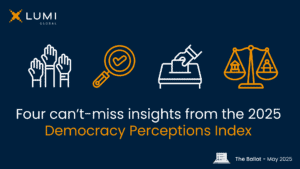“Sustainability” isn’t just a word companies use to market themselves – it is the defining goal of a world which recognizes that it should move towards living in harmony with our natural environment. The question is, as both companies and governments set lofty targets in the name of sustainability, where do digitalization and online voting come into the equation? We set out to both answer this question and provide some food for thought in our latest piece.
The Conversation Around Digitalization and Sustainability
Before setting off on our exploration of the topics, it might help to start by defining some concepts. First and foremost, when we refer to “sustainability,” we are actually talking about an idea built upon three interrelated “pillars” – social, economic, and environmental. As put by the UN, “sustainability ”is “promoting the integrated and sustainable management of natural resources and ecosystems that supports…economic, social, and human development.” Therefore, the point of meeting “Sustainable Development Goals” is ensuring that human society can continue to exist long into the future by living in harmony with one another and our natural environment while continuing to develop economically.
Naturally, given that the economic pillar of “sustainability” has been prioritized to an unhealthy extent for much of the last century, its inclusion is not without controversy. For brevity’s sake, and to not wedge ourselves into larger discussions about what belongs where, this article will stick to using the UN’s definition of sustainability and focus largely on the environmental pillar.
So, now having a working definition of sustainability, what about “digitalization?” All hype and marketing aside, we will term “digitalization” to be a “megatrend changing societies and economies via use of digital technologies.” Expectedly, as we have seen smartphones and computers spread while services move online to common digital portals, this “megatrend” is feted as something which can help level the playing field between citizens of different classes by making services more accessible and faster.
The Danish MInistry of Digitalization and Gender Equality perhaps sums up the lofty goals of digitalization best, stating that their goal is “making it easier to be Danish and run a business in Denmark while making sure that everyone is along for the ride.” They also add that digitalization to them is about “raising the quality of public service,” “freeing up labor,” and “accelerating the green transition.”
In fitting with the title of this section, let’s now consider the relationship between the two concepts we have covered. The European Union itself is a strong believer in the potential for digitalization to go hand-in-hand with sustainability, with the Council of the EU writing that data analysis made possible by digitalization can “contribute to achieving the goals of the European Green Deal.” They also emphasize that the opportunities are rife for public-private environmental cooperation facilitated digitally, which can in turn “reduce greenhouse gas emissions.”
To provide a concrete example, moving more meetings, elections, and other events online can play an important role in reducing emissions associated with travel, in particular air travel. This is corroborated by the World Economic Forum, which argues that digital technology can “cut emissions by 15%.”
As we’ll cover later on, digitalization doesn’t necessarily lead to sustainable practices and vice-versa. That being said, we certainly believe in its potential to make a positive impact.
Online Voting’s Place in the Discussion
Having tackled the larger context of digitalization, of which online voting is a part, we now get to the question at hand: how might online voting play a role in reducing emissions as part of a green transition? As it turns out, in spite of optimistic predictions, there hasn’t been much research done on the topic specifically. We will therefore use this section to do a little research ourselves and fill in the gaps.
A useful place to start is resource use. In paper ballot-based elections, each stage of the election requires resources to run: advertisements, flyers, and promotional goods made from paper and plastic before the election, ballots made of paper during the election, and (generally) vehicles and staff to transport as well as count ballots. Though emissions from the paper industry have declined more recently, there is clear potential for fully digital elections to obviate the need for using the amount of resources elections use now.
Now, to illustrate a realistic scenario where voting online can significantly reduce emissions, let’s take a hypothetical trip to the US, where 71% of passenger kilometers traveled are done via car or motorcycle. For each kilometer traveled, these vehicles will emit on average 0.25 kilograms of carbon dioxide (CO2). Not too much right? Well, at first glance maybe, but consider how far citizens need to travel to vote in company, organizational, or government elections. An average American worker has a round-trip commute of 67.62 km to work and back, resulting in 16.8 kg of CO2 emissions. Meanwhile, in a personal example, a round-trip outing to the nearest polling place in a typical American suburb clocked in at 11.2 km, equivalent to 2.79 kg of CO2.
This is not to say that technology is always environmentally friendly, as issues with emissions and e-waste remain. But, while we’re at it, let’s do some more math with the numbers we obtained above. According to MIT, the most carbon-intensive internet activity is streaming or video conferencing, which can emit up to 1 kg of CO2 per hour of use. Say that you, an American voter, take part in a live conference voting event and cast your ballot via the internet instead of driving to your workplace or polling place to vote. In the absolute worst case scenario, by voting online and not driving, you have reduced your CO2 emissions by anywhere from 60% to 94%. This doesn’t even include emissions associated with creating election materials and paper ballots. Not too shabby, eh?
Interestingly enough, one study from 2009 commissioned by a private company found that, in a company board election with 40,000 voters, CO2 emissions dropped 98% when the vote took place online in lieu of in person with paper ballots. In tandem with a larger green transition in which more electricity is produced by renewable sources, the potential for online voting to help decarbonize elections of all kinds cannot be understated.
Taking the Initiative
To circle back to an earlier talking point, does digitalization always go hand-in-hand with sustainability? There is strong evidence that it can, but it rests upon a few caveats.
Our first issue can be summed by “Jevon’s paradox,” which states that improvements in the efficiency of technology can end up causing higher energy demand, thus leading to more energy consumption than before. A relevant example here could be internet usage, as currently two-thirds of the world is online. If the remaining one-third join, we risk ending up with more emissions than before should this growth in demand not be offset by more investment in green energy.
The question posed at the beginning of this section doesn’t have a clear yes or no answer; it is instead a question to ponder when considering the broader impact of online voting and digitalization. We have shown that online voting can already make a mathematically significant impact on reducing emissions in the near term, but it is also important to recognize that it must be part of a broader solution to environmental issues which includes further transformations to our consumption levels, our energy grids, and efficiency. It is also important to note that, as previously covered by us, shifting to voting online is something which, while eventually supported by voters, takes time to successfully implement.
Circling back to voting, there are two other factors which may also make an impact on “being green” when it comes to voting: the policies for which we vote and the electoral systems we use. Starting with the obvious, at least in national elections, voting and campaigning for climate-friendly proposals, groups, and/or candidates has a large impact on reducing emissions. When it comes to electoral systems, setups such as instant runoff voting, single transferable vote, and ranked-choice voting help reduce resource use since they only require voters to vote once and winners can be found from a single voting round, in contrast to elections which require a runoff election should no candidate receive a majority of votes the first time.
To be upfront, we are not here to tell readers what they absolutely must do to help make digitalization align with sustainable environmental practices. Rather, we hope that, through this piece and our work in advancing elections which require fewer natural resources to run, we can continue to inspire others to think about how we might better align our goals of sustaining democracy and living in harmony with the natural environment for generations to come.


